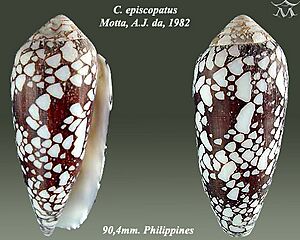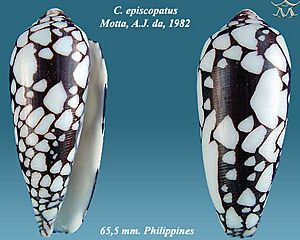Conus episcopatus facts for kids
Quick facts for kids Conus episcopatus |
|
|---|---|
 |
|
| The shell of a dignified cone snail. | |
| Conservation status | |
| Scientific classification | |
| Synonyms | |
|
The Conus episcopatus, also known as the dignified cone, is a type of sea snail. It's a marine gastropod (which means "stomach-foot") and belongs to the Conidae family. This family includes all the different kinds of cone snails.
Just like other cone snails, these snails are predatory (they hunt other animals) and venomous. This means they can "sting" humans. So, if you ever see one alive, it's important to be very careful and not touch it.
Contents
What Does It Look Like?
The shell of the dignified cone snail can be anywhere from about 40 mm (1.5 inches) to 115 mm (4.5 inches) long. It has a long, tall shape, like a cone with a pointed top.
The shell is quite thick and heavy. It has a shiny surface and often features raised ridges or ribs along its length.
The colors of the shell can be very different from one snail to another. However, they usually have a base color of white or cream. On top of this, they have darker or lighter bands, blotches, or spots. These patterns can be very detailed and unique. This is why cone snails are often collected by people who love shells.
How Does It Hunt?
The dignified cone snail is venomous. It uses its venom to catch and kill its prey. The venom is delivered through a special harpoon-like tooth. This tooth is called a radula tooth. It is located on a part of the snail called the proboscis.
The venom from some types of cone snails can be very toxic and dangerous to humans. This is why it's super important to be careful when handling them.
Where Does It Live?
You can find Conus episcopatus in warm, tropical and subtropical waters. They live in the western Atlantic Ocean, from the Gulf of Mexico all the way to the Caribbean Sea.
These snails like to live in coral reefs and other shallow ocean areas. They eat other small marine invertebrates. This includes animals like worms, other molluscs, and crustaceans.
Where Can You Find Them?
This marine snail lives in the tropical Indo-West Pacific region. You can find them near the Mascarenes islands, off the coast of India, and near Queensland, Australia.
Gallery







